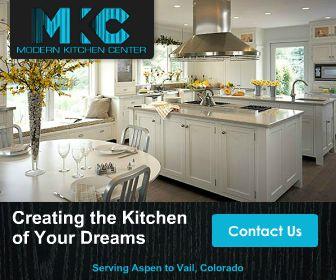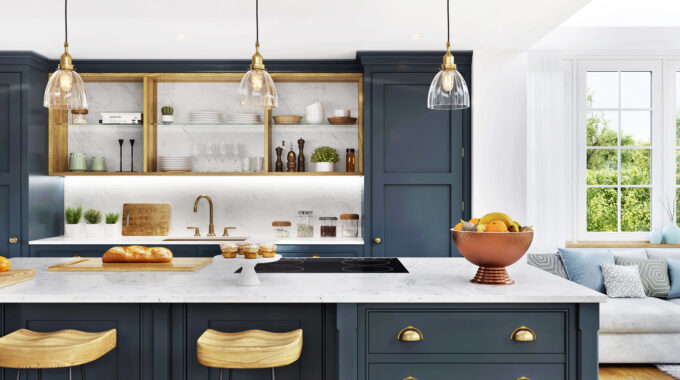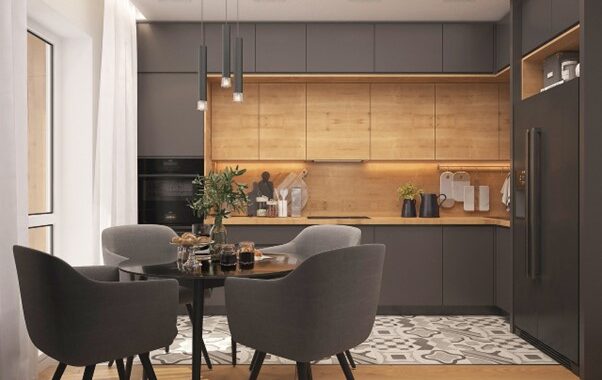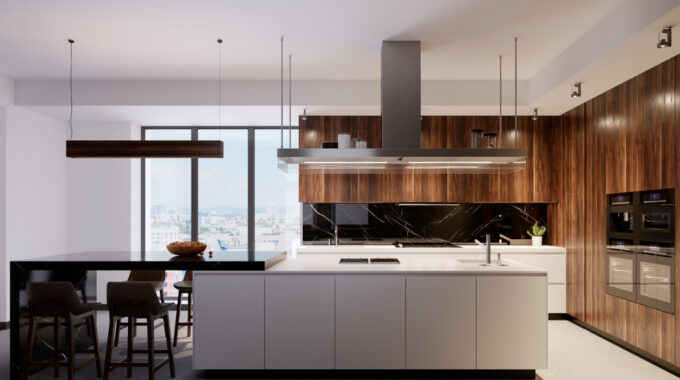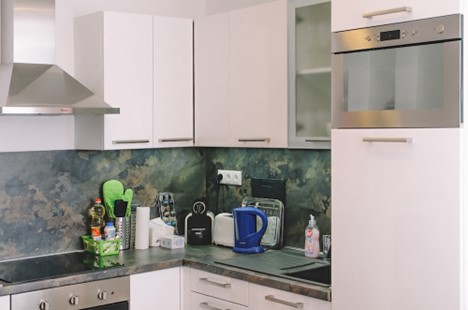
Space-Savvy Kitchen Solutions: Simple Strategies to Maximize Space
The kitchen is the beating heart of every house – the place where loved ones come together to share delicious meals and good company. Beyond the delectable aromas and comfortable warmth, however, there is an underlying foundation that powers a kitchen’s ultimate potential: organization.
The significance of a well-organized kitchen cannot be overstated. It’s not only about appearances; it’s about establishing a harmonious atmosphere that combines functionality and comfort, ensuring that every culinary venture is a breeze.
When every tool has its place, every ingredient is within arm’s reach, and movement flows seamlessly, cooking transforms from a mere task to a joyous ritual. A well-organized kitchen saves time, eliminates the hassle of having to search for tools or ingredients, and enhances the overall cooking experience. Moreover, it makes the space safer, ensuring that sharp or hot objects are not haphazardly placed where they could lead to accidents.
However, achieving this utopian kitchen is not always an easy task, especially for homeowners with smaller kitchens. The constraints of limited space become daunting challenges in the quest for a clutter-free environment. Every inch becomes a prime piece of real estate, every corner akin to a goldmine. The constant battle to find space for new gadgets or pantry items, the puzzle of arranging things efficiently, and the desire to maintain a visually appealing space make small kitchen organization a hard-to-solve puzzle.
Yet, within every challenge lies an opportunity. The right strategies and solutions can help transform even the smallest kitchen into a model of efficiency and attractiveness.
Understanding the Kitchen’s Potential
Every kitchen, irrespective of size, holds untapped potential waiting to be unearthed. One might get accustomed to a certain arrangement or layout, and fail to notice often-hidden nooks and corners that can be leveraged for added efficiency.
It is not uncommon to overlook spaces like the insides of cabinet doors, the sides of refrigerators, or even the often-wasted areas beneath the sink. Taking note of such spots can allow homeowners to expand their storage solutions and create a kitchen that truly utilizes every available inch. Installing hooks, magnetic strips, or small shelves can instantly transform these oft-ignored spaces into valuable storage zones.
But, it is not just about storage; the modern kitchen needs to be a multi-functional hub. Today’s fast-paced world means that kitchen is not only a place to cook but also one that can be used to work, study, or even for entertainment. Embracing multi-functionality means that a kitchen counter can double-up as a breakfast bar, work desk, or serving space during parties or gatherings. Fold-out tables and movable islands offer versatility, catering to multiple needs throughout the day.
Optimal Layout and Design
a) The Power of the Work Triangle
For decades, the work triangle has been a fundamental principle in kitchen design. It focuses on arranging the three most often used locations — the sink, stove, and refrigerator — to form an imaginary triangle. The reasoning is simple: they are the most frequented spots, and having them close together is ensures minimal movement, saving both time and energy. Efficient location improves workflow, decreases foot traffic clashes, and speeds up the cooking process.
While each kitchen’s size and constraints are unique, following the work triangle approach optimizes available space, resulting in a layout that is both functional and intuitive.
b) Open Shelving and Vertical Storage
Modern kitchens often encounter the dual challenge of limited space and increasing storage requirements. Enter open shelving and vertical storage, solutions that merge aesthetics with utility. In addition to providing easy access to frequently used items, open shelving also presents the opportunity to showcase beautiful dishes, plants, and decorative items. It creates the illusion of space and makes the kitchen seem larger.
Vertical storage, meanwhile, taps into the often underutilized upper sections of the kitchen. Utilizing the vertical plane, tall cabinets, stacked shelves, and hanging pot racks maximize storage without consuming precious floor space.
These strategies, when combined, provide an open, airy impression while ensuring that everything has a defined spot.
c) Integrating Multi-Functional Furniture
Multi-functional furniture can be a game-changer when it comes to adaptive and space-efficient kitchens. Consider foldable tables, for instance. When extended, they can serve as additional prep areas or dining spaces. Upon folding, they seamlessly blend into the wall or act as a narrow counter, freeing up floor space. Similarly, pull-out counters can act as an extended workspace and be retracted when they are no longer needed.
But multi-functional furniture is not restricted to counters and tables. Think of chairs that offer storage compartments, islands with built-in wine racks, or benches that open up to reveal storage bins. Beyond serving the primary purpose for which they were designed, such pieces of furniture also address the ever-present need for more storage or workspace. The beauty of multi-functional furniture lies in its ability to provide solutions that are both space-saving and versatile. It ensures that the kitchen remains an accommodating and flexible space, capable of adapting to different tasks and needs.
Innovative Storage Solutions
a) In-Cabinet Organizers and Pull-outs
Cabinet interiors, while often overlooked, are spaces brimming with potential. Traditional shelving only utilizes a small portion of the possibilities. In-cabinet organizers and pull-outs are a revelation in this regard.
Layered trays, for example, can double or even triple the storage capacity of a drawer, ensuring cutlery, tools, and small kitchen gadgets are neatly arranged and easily accessible. Vertical dividers are ideal for storing baking sheets, cutting boards, and large flat dishes in an organized manner, keeping them upright and orderly.
Pull-out racks, on the other hand, bring the cabinet contents to you. Rather than fumbling through a deep cabinet, these pull-outs present everything in a straightforward, ordered manner, making it easier to reach for that pot or pan in the back.
These innovations not only increase storage capacity but also make retrieving and storing items considerably more ergonomic and user-friendly.
b) Utilizing Dead Spaces
Every kitchen has them: awkward corners and spaces that appear to be impossible to use properly. With a bit of innovation, though, these ‘dead spaces’ can be turned into valuable storage assets. Corner cabinets, for example, are a great solution for those tricky kitchen corners. They make the most of an otherwise wasted space by using rotating carousel shelves or pull-out systems.
The area under the sink, which is sometimes overlooked due to plumbing fittings, can also be efficiently harnessed. Pull-out trays or baskets can accommodate housekeeping supplies, garbage cans, and even compost bins. Then, there is the ingenious toe-kick drawer. At first glance, it appears to be merely the base of a cabinet, but a gentle press exposes a drawer that is ideal for storing flat items such as baking trays and placemats.
c) Magnetic and Pegboard Systems
When counter and cabinet space is at a premium, walls come to the rescue. Magnetic and pegboard systems are two of the most effective kitchen wall storage choices. When mounted on walls or behind cabinet doors, magnetic strips become the ideal storage space for knives or other metallic instruments, keeping them within arm’s reach while freeing up valuable counter space.
Pegboards, on the other hand, offer unparalleled versatility. With adjustable pegs, they can hold everything from pots and pans to utensils and dishcloths. As pegboards are adaptable, they can change with your storage needs. They also offer a sense of DIY charm to the kitchen, combining practicality with aesthetics.
The Role of Décor and Visual Elements
a) Using Light Colors and Mirrors
Color and reflective surfaces play defining roles in defining a room’s perception, especially in smaller kitchens. Light colors, since they reflect more light, can make a room feel airy, spacious, and open. Whites, gentle grays, and pastel colors can effectively brighten up the space, giving even the smallest kitchens an expansive feel. Using these colors on the walls, cabinetry, and even counters can result in a cohesive aesthetic that keeps the room from seeming cramped.
The magic, however, does not stop with colors. With their reflective abilities, mirrors can amplify this illusion of space. When strategically situated, such as on a backsplash or cabinetry, mirrors can double the visual depth of a room. They not only reflect light but also create a sense of continuity, making walls appear as though they stretch further than they do. The bonus? They also add a touch of luxury and elegance, elevating the kitchen’s overall ambiance.
Light colors and mirrors work together to create a stunning illusion of space in a small kitchen. Visually addressing the spatial challenge, they ensure that the kitchen does not feel confined or claustrophobic.
b) Minimalistic Approach
Less is sometimes more, especially in the world of design. A minimalistic approach, rooted in simplicity and functionality, is more than just a design trend; it is a philosophy that can be especially beneficial for confined spaces. The overarching approach here is to de-clutter, both physically and visually.
The first step towards this approach is determining what is essential and what is not. This could include getting rid of infrequently used kitchen gadgets, unnecessary utensils, or even superfluous sets of dishes that are only used once a year. By reducing items to only what is needed, you can make your kitchen roomier and more organized.
However, minimalism is as much about design coherence as it is about reducing items. Opting for simple cabinetry without ornate designs, choosing uniform hardware, and avoiding overly busy patterns on walls or countertops create a streamlined look. This lack of visual clutter creates a more open, clean, and breathable environment.
Moreover, minimalism places an emphasis on functionality. This means that every item left in the kitchen should serve a purpose, either functional or aesthetic. By focusing on utility and simplicity, a minimalistic approach ensures that the kitchen remains functional without appearing cluttered.
a) Space-Saving Appliances
In this technological era, kitchen appliances and equipment has experienced a transformative journey, adapting to the needs of today’s urban spaces. As apartments become smaller and space becomes a premium, compact and multi-functional devices are no longer merely convenient but indispensable.
Consider, for example, the rise of under-the-counter refrigerators that provide adequate storage without towering over the kitchen space. Or, the slim-line dishwashers specifically designed for smaller households. Then there is the miracle of multi-functional appliances – a single appliance that can blend, chop, cook, and even ferment. These advances eradicate the need for countless bulky appliances, freeing up counter space and keeping the kitchen uncluttered.
b) Smart Kitchen Solutions
The ‘smart’ revolution has not left the kitchen unaffected. Modern technological solutions seek to increase kitchen productivity by making operations easier, faster, and more intuitive. Hands-free, voice-activated assistants can now read out recipes, set timers, and even prepare ovens. Then, there are smart refrigerators with transparent displays that allow users to peek inside without opening the door, saving time and electricity.
Integrated apps can now monitor cupboard stock, recommend meals based on available ingredients, and even place grocery orders when supplies are running short. Smart lighting systems adapt to the time of day or activity, providing proper lighting for cooking, dining, or cleaning.
Wrapping Up
The modern kitchen, no matter how small or large, is a testament to the human inventiveness. From spatial layouts that enhance productivity to design elements that amplify visual space to technological advances redefining functionality, every aspect of the kitchen can be optimized for space efficiency.
Today’s solutions focus on packing more into less space while improving aesthetics, functionality, and overall experience. Small kitchens, once considered to be design obstacles, have since become a canvas for innovation. They prove that the right strategies, sprinkled with some creativity, can indeed turn limitations into opportunities.
Give Modern Kitchen Center a call at (800) 876-0075 and let us help you with your new kitchen!



